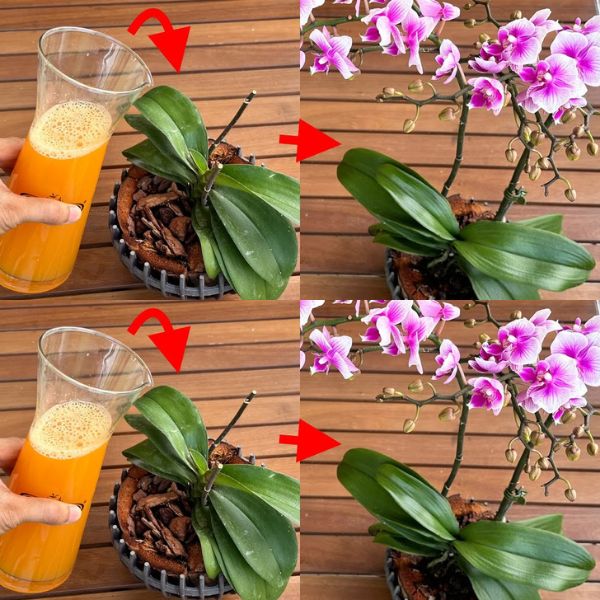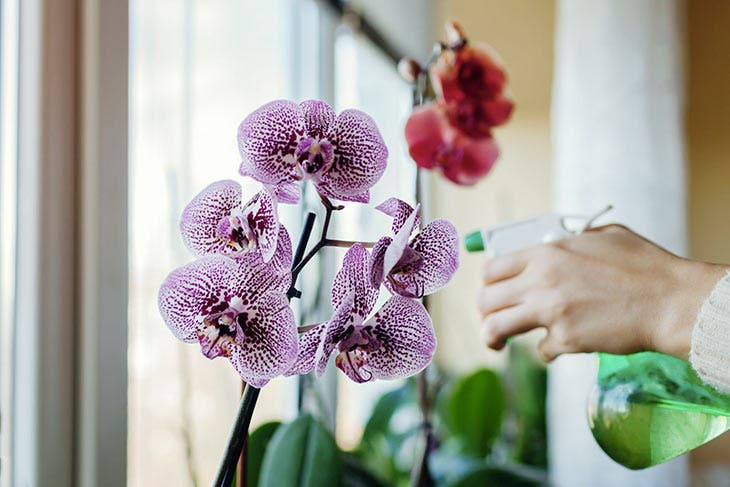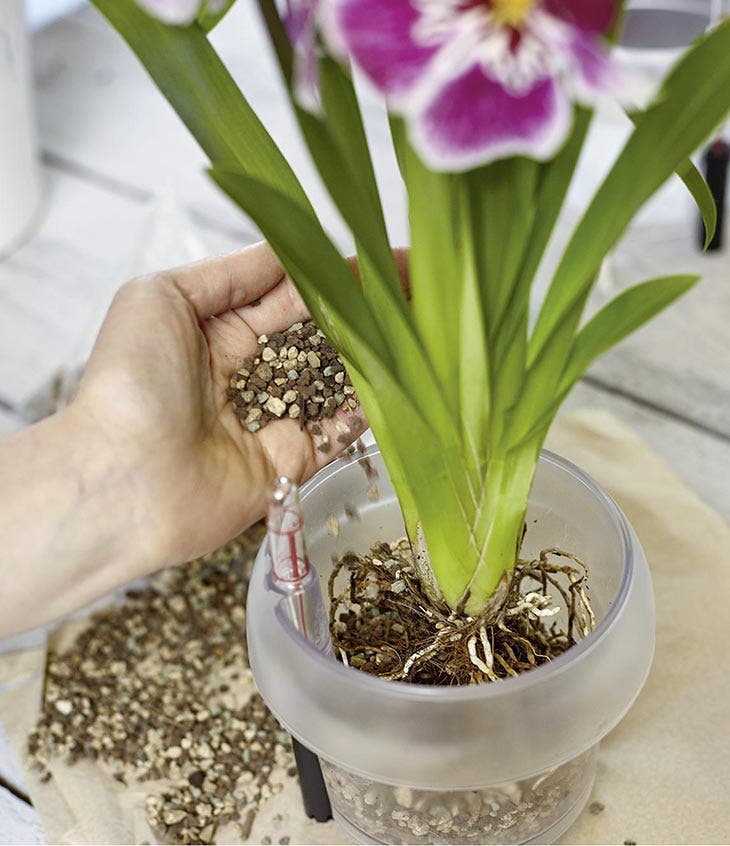ADVERTISEMENT
How to get your orchids to bloom again? The step-by-step guide

Growing conditions
Phalaenopsis grows wild on trees and rocks in the Asian and Australian rainforests.
Temperature: between 18 and 25° during the growing period. It is best not to expose the plant to a temperature below 20°.
At night, the temperature should not fall below 16°C, for young plants, a few additional degrees are necessary. Phalaenopsis tolerate higher temperatures as long as they have good humidity.
Orchid: mild fertilizer
Apply very light doses of fertilizer at the beginning of the season (March/April). Do not apply fertilizer in winter because the plant is dormant. Avoid bar fertilizers, because the fertilizer goes directly onto the roots, leading to the death of the latter or, at best, to burns. Do not fertilize young plants and newly transplanted plants.

How to water an orchid?
Watering should be done regularly but not excessively, at the risk of rotting the roots. If the roots (rhizomes) become soft and black, watering should be spaced out and the pot should be drained well. In spring and especially in summer, water twice a week, especially when it is hot. In winter, reduce watering to twice a month. Get used to weighing the pot. If the latter is light, water it. Preferably water the base of the plant in the morning with water at room temperature. Avoid hard water because the orchid is very sensitive to it. The plant should never be soaked in water, except during occasional baths.
The right location for an orchid.
If this plant needs a lot of light, avoid direct sunlight. Avoid cold drafts. Never place it near cut flowers and fruit. Fruits such as tomatoes, bananas and apples produce high levels of ethylene. This gas will influence the production of ethylene in the plant and therefore cause faster ageing of flowers and leaves. Phalaenopsis, sensitive to ethylene, could then present a drop of buds, flowers and/or leaves. Some orchids can spend the summer outdoors (Cymbidium), others cannot (Phalaenopsis).
Replant the orchid
Phalaenopsis can be repotted all year round, but it is best to concentrate on spring before the warm weather and the end of summer. Winter is not conducive to a good recovery of vegetation. Repotting during this period should be avoided or reserved for plants in very poor condition to wait for spring. Do not repot during flowering and in the presence of stems. To stimulate flowering, or the awakening of a bud, in Phalaenopsis, you can cut the faded flower stem above the second or third node (counting from the base). In other orchids, this stem will be cut 2 or 3 cm from the base.

Transplant technique
1- Carefully remove the plant from its original pot.
2- Remove all dead roots from their attachment points.
3- Aerial roots longer than 20 cm should be shortened. Remove old flower stems.
4- Fill half of the new pot with its substrate.
5- Position the plant in the center.
6- Fill the rest of the pot with the substrate, pressing very lightly.
7- Keep the plant in a humid and warm environment but without direct sunlight and moisten the substrate after transplanting, then suspend watering for 3 to 4 days.
Choosing a pot and planter for an orchid.
Choice of pot: take 1 pot with a larger diameter. For example: 12 cm, take 14 cm. Choice of pot: the bottom can be flat if when you water you use the soaking technique or you can take a pot with a small rim at the bottom so that you can put the water up to the edge and the irrigation will be done by capillarity. Preferably choose a transparent glass planter. You will be able to observe the quality of hydration of the roots and they will benefit from it to fill themselves with light. The roots must always be moist and green, otherwise the plant will dry out.
Orchid: The Keiki Harvest
The production of keikis is a method of reproduction of epiphytic orchids. Keikis result from the development of adventitious buds generated by the spontaneous multiplication of vegetative cells on stems, leaves and roots. It is a type of natural cloning. Keikis differentiate and develop on stems or on the stems of old flowers.
The appearance of keikis is not always a good sign: ageing of the plant or the part that supports them, suffering linked to poor growing conditions. The appearance of keikis is related to the absence or inhibition of flowering (with the exception of some Phalaenopsis species). Keikis are taken when their roots have reached a sufficient size (4-5 cm and have at least 3 leaves). They are then transplanted into a pot containing a substrate identical to that used for the adult plant, but with a finer grain. Development is rapid and the plant can flower in a very short time.
How to combat mealybugs naturally?
Dilute in 1 liter of water: 1 teaspoon of black soap or liquid hand soap, 1 teaspoon of isopropyl alcohol; 1 teaspoon of vegetable oil, plain salad oil.
Spray all the leaves; then rub with a cloth to avoid burning the leaves; place the plant in the shade. Repeat the operation several times if the scale insects resist.
Precautions when buying a plant
After purchasing a phalaenopsis, place it away from others for a while (15 days on average). Then you will be sure that the plant is not sick. Indeed, with the change of growing conditions, the plant can develop diseases (appearance of parasites, scale insects, etc. already present on the plant before purchase). To properly select a phalaenopsis, carefully observe its roots (almond green to deep green), the underside of the leaves (bright green and fat leaves) and the condition of the flowers. Never buy orchids in the fruit and vegetable section – very bad location (gasoline)!
colors and aromas
There are several colours of orchids: from white to yellow, pink, purple, orange-red… But there is no blue Phalaenopsis, it is actually inky. The plant turns white again the next time it blooms. Colours come in solid, spotted, striped or dotted form.
The orchid family, which includes around 25,000 species, offers a multitude of colours, but also delicious scents. In addition to their beauty, the different varieties are distinguished by delicate, aromatic or fruity fragrances. For example: Phalaenopsis cochlearis. It has a delicate honeysuckle scent with a hint of lily of the valley; or the bergamot-scented Phalaenopsis Sweet Memory with its waxy petals tinted in a beautiful pink and fuchsia shade. Others are original orchids, such as the Eternal Wind ‘Summer Dream’ brassia, a beautiful fragrant orchid with a honeyed scent and star-shaped flowers.
Did you know?
To protect themselves from desiccation, plants and trees shed their buds, flowers and leaves. In cut flowers and potted plants, this drooping is often the result of an overproduction of ethylene, the only known natural gaseous plant growth hormone. Ethylene gas regulates the ripening and aging of cut flowers, potted plants, fruits and vegetables. It is therefore used to promote fruit ripening and flowering in potted plants.
The most common orchid diseases.
1 – Typical damage caused by excess moisture: soft leaves, damaged roots. The plant has spent too much time in water.
2 – Rhizome rot, probably the most serious damage to a phalaenopsis. Caused by various types of rot, fungi and bacteria, as a result of cultivation errors.
3 – Bud drop, here too there are multiple causes, usually lack of light, cold or various cultivation errors.
4 – Sunburn on the leaves, solution: change the location of the orchid, without direct sunlight.
5 – Beginning of bacterial attack on the leaf. Favored by too much humidity and lack of ventilation. Cut off the damaged part.
6 – Mealybugs. Treat quickly with an organic product.
7 – Attack by scale insects. Use a suitable product.
8 – Lack of water. Give it a bath.
9 – Dead orchid.
Symptoms
- Insufficient or stunted growth.
- Spots on the surface of the leaves, first yellowish white and then brown.
- Irregular but well-marked yellowish spots on and under the leaves, turning brown and dry.
- Brown and dry leaf tips.
- Limp shoots, fallen buds.
Causes
- Wilted substrate, containing mold. Rotten roots. Location too dark. Insufficient fertilization.
- Plant exposed to the sun’s rays by an orchid that cannot stand it.
- Collapse of tissues under the effect of heat that attacks the root system. Prolonged exposure to an excessively dry environment.
- Air that is too dry, saturation of the substrate due to excess fertilizer or water that is too calcareous. Stagnant humidity.
- Insufficient light, cold roots, insufficient nutrition. Air loaded with ethylene.
Solutions
- Remove the phalaenopsis. Clean the roots by cutting off any that are not healthy. Pot with new substrate. Place in a well-lit place.
- Protect from direct sunlight.
- Choose a cooler, more humid and slightly shaded location.
- Increase atmospheric humidity. Rinse the substrate with running water. Temporarily suspend the application of fertilizers.
- Avoid sudden cooling. Do not change the orientation of the orchid relative to the light source during bud formation.
ADVERTISEMENT